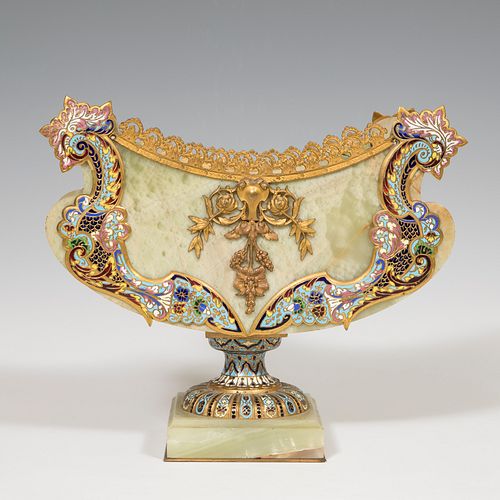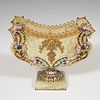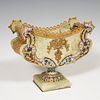Center; Work near FERDINAND BARBEDIENNE; Paris, circa 1880. Onyx, gilt bronze and cloisonné enamel.
Lot 33
About Seller
Setdart Auction House
Carrer Aragó 346
Barcelona
Spain
Setdart Subastas was born in 2004 and is currently the first online art auction in Spain with solidity, prestige and reliability guaranteed by our more than 60,000 users. Setdart has a young, dynamic and enterprising team ready to successfully manage the purchase and sale of art works through custom...Read more
Categories
Estimate:
EUR€1,500 - EUR€2,000
$1,562.50 - $2,083.33
Absentee vs Live bid
Two ways to bid:
- Leave a max absentee bid and the platform will bid on your behalf up to your maximum bid during the live auction.
- Bid live during the auction and your bids will be submitted real-time to the auctioneer.
Bid Increments
| Price | Bid Increment |
|---|---|
| EUR€0 | EUR€10 |
| EUR€200 | EUR€25 |
| EUR€500 | EUR€50 |
| EUR€1,000 | EUR€100 |
| EUR€3,000 | EUR€200 |
| EUR€5,000 | EUR€500 |
| EUR€10,000 | EUR€1,000 |
| EUR€20,000 | EUR€2,000 |
| EUR€50,000 | EUR€5,000 |
About Auction
By Setdart Auction House
Nov 10, 2021
Set Reminder
2021-11-10 08:00:00
2021-11-10 08:00:00
America/New_York
Bidsquare
Bidsquare : 19th & 20th Century paintings and Decorative Arts
https://www.bidsquare.com/auctions/setdart-auction-house/19th-20th-century-paintings-and-decorative-arts-7800
Setdart Auction House sofia@setdart.com
Setdart Auction House sofia@setdart.com
- Lot Description
Center; Work near FERDINAND BARBEDIENNE; Paris, circa 1880. Onyx, gilt bronze and cloisonné enamel. Presents breakage in the back area. Measurements: 24 x 28 x 11 cm. Centerpiece made of onyx with decoration in gilded bronze and cloisonné enamel The foundry F. Barbedienne was founded in Paris in 1838 by Ferdinand Barbedienne and Achille Collas, the latter inventor of a machine to mechanically reduce the format of the sculptures. At first they were dedicated to the production of bronze reproductions of sculptures from Roman and Greek antiquity, such as the one presented here. Their first contract to publish works created by a living artist was signed in 1843, with the sculptor François Rude. During the following years, after surviving the economic collapse of 1848, the Barbedienne house signed contracts with many of the sculptors active in Paris at the time, including David d'Angers, Jean-Baptiste Clesinger, Antoine Louis Barye and others. Achille Collas died in 1859, after which Ferdinand Barbedienne was left as sole partner in a firm that had grown to approximately three hundred workers. In 1865 he was appointed president of the Association of Broncists, a position he held until 1885. However, the outbreak of the Franco-Prussian War in 1870, and the consequent shortage of raw metals, forced Barbedienne to interrupt his artistic production, although he signed a contract with the French government to make cannons, which allowed him to keep the foundry open. After the war, he resumed his sculptural production and put even more effort into signing contracts with various sculptors. At his death in 1891, he was praised as the best foundryman in France, and was called by Albert Susse "a source of pride for the nation". The management of the foundry then fell to Barbedienne's nephew, Gustave Leblanc, who continued the high quality of production and opened branches in Germany, England and the United States.
- Shipping Info
-
In-house shipping available. Please inquire at admin@setdart.com.
-
- Buyer's Premium



 EUR
EUR CAD
CAD AUD
AUD GBP
GBP MXN
MXN HKD
HKD CNY
CNY MYR
MYR SEK
SEK SGD
SGD CHF
CHF THB
THB
















